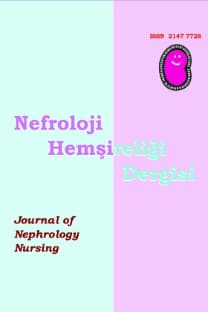Diyaliz Hastalarında Semptom Yönetimi
Son dönem böbrek hastalığı (SDBH) nın tedavisindediyaliz tekniği ve teknolojisinde son 40 y›ldaönemli ilerlemeler görülmesine karşın, intra/interdiyalizmorbiditesinde fazla bir değişliklik olmamıştır. Morbidite,hemodiyaliz süreci ile ortaya çıkan fizyolojikdeğişikliklere bağlı çeşitli semptomları kapsamaktadır.SDBH olan hastaların semptom yönetimine odaklananözelleşmiş bir bakımı alamamasının nedeni olaraksemptomların etkili bir şekilde kontrol edilememesive hemşirelerin semptom yönetiminde, bakımınplanlanması ve uygulanmasında yetersiz kalması gösterilmektedir.Diyaliz hastalarına bakım veren hemşirelerinsemptom yönetimi ve liderlik rollerini geliştirmedeeğitim programlarından ve örnek klinik uygulamalardanyararlanarak kendilerini geliştirmeleri beklenmektedir.Semptom yönetiminin amacı; semptomyönetimi alanında bilgi geliştirmek ve sağlık bakımelemanlarının uygulamaları ile kişilerdeki semptomlarıiyileştirmektir. Bu semptomların başarılı bir şekildetedavi edilmesinin, diyaliz hastalarının yaşlam kalitelerindede önemli iyileşmeler sağlayacağı ileri sürülmektedir.
Anahtar Kelimeler:
Diyaliz, Semptom yönetimi, Hemşirelik bakımı, Anoreksiya, Kramplar.
___
- 1. McLaren P, Hunter C. Sodium profiling: The Key to reducing symptoms of dialysis. Nephrology Nursing Journal July-August 2007; 34( 4): 403-414.
- 2. Bonomini V, Coli U, Scolari, MP. Profiling dialysis: A new approach to dialysis intolerance. Nephron1997; 75: 1-6.
- 3. Arieff AI . Dialysis disequilibrium syndrome: Current concepts on pathogenesis and prevention. Kidney International 1994; 45:629-635.
- 4. Tang, H.U, Wong, S.H., Chu, K.H., et al. Sodium ramping reduces hypotension and symptoms during haemodialysis. Hong Kong Medical Journal 2006;12 :10-22.
- 5. United States Renal Data System. USRDS 2005 Annual Data Report: Atlas of End-stage Renal Disease in the United States. Bethesda, MD: National Institutes of Health, National Institute of Diabetes and Digestive and Kidney Diseases; 2005.
- 6. Jablonski A. Level of symptom relief and the need for palliative care in the hemodialysis population. Journal of Hospice and Palliative Nursing 2007;9(1):50-58.
- 7. Moss AH, Holley JL, Davison SN, et al. Core curriculum in nephrology. Palliative care.Am J Kidney Dis 2004;42(1):172-185.
- 8. World Health Organization. Cancer Pain Relief and Palliative Care. (Technical report series 804). Geneva: World Health Organization; 1990.
- 9. Kinzbrunner BM. Palliative care perspectives. In: Kuebler KK, Davis MP, Moore CD, eds. Palliative Practices: An Interdisciplinary Approach. St. Louis, MO: Mosby; 2005:3-28.
- 10. Poppel DM, Cohen LM, Germain MJ. The renal palliative care initiative. J Palliat Med 2003;6(2):321-326.
- 11. Dodd M, Lee K, Carrieri V. Symptom management model. Journal of Hospice and Palliative Nursing 2005; 7(21):23-36.
- 12. Parfrey PS, Vavasour H, Henry S, et al. Clinical features and severity of nonspecific symptoms in dialysis patients. Nephron 1988;50(2):121-129.
- 13. Curtin R, Bultman D, Thomas-Hawkins C. Hemodialysis patients' symptom experiences: Effects on physical and mental functioning. Nephrol Nurs J 2002;29(6):562-574.
- 14. Dodd MJ, Janson S, Carrieri-Kolhman V, et al. Advancing the science of symptom management. J Adv Nurs 2001;33:668-676.
- 15. The University of California, San Francisco School of Nursing Symptom Management Group. A model for symptom management. J Nurs Scholarsh 1994;26:272-276.
- 16. Foley KM, Gelband H. Improving Palliative Care for Cancer. Summary and Recommendations. Washington, DC: National Academy Press; 2003.
- 17. Movilli E, Camerini C, Viola BF, et al. Blood volume changes during three different profiles of dialysate sodium variation with similar intradialytic sodium balances in chronic hemodialyzed patients. American Journal of Kidney Disease 1997; 30: 58-63
- 18. Stiller S, Btmnie-Schom E, Grassmann A, Uhlenbusch-Korwer I, Mann H. A critical review of sodium profiling for hemodialysis. Seminars in Dialysis 2001: 14: 337-347.
- 19. Bossola M, TazzaL, Giungi S, Luciani G. Anorexia in hemodialysis patients: An update. Kidney International 2006; 70, 417–422.
- 20. Burrowes JD, Larive BL, Cockram DB et al. Effects of dietary intake, appetite, and eating habits on dialysis and non-dialysis treatment days in HD patients: cross sectional results from the HEMO study. J Renal Nutr 2003; 13: 191–198.
- 21. Kalantar-Zadeh K, Block G, McAllister CJ et al. Appetite and inflammation, nutrition, anemia, and clinical outcome in HD patients. Am J Clin Nutr 2004; 80: 299–307.
- 22. Suri RS, Nesrallah GE, Mainra R et al. Daily hemodialysis: a systematic review. Clin J Am Soc Nephrol 2006; 1: 33–42.
- 23. Ahsan M, Gupta M, Omar I, et al. Prevention of hemodialysisrelated muscle cramps by intradialyticuse of sequential compression devices: a report of four cases. Hemodial Int 2004; 8:283–286.
- 24. Khajedehi P, Morerlou M, Behzadi S, et al. A randomized, double- blind, placebo-controlled trial of supplementary vitamins E, C and their combination for treatment of haemodialysis cramps. Nephrol Dial Transplant 2001; 16:1448–1451.
- 25. Canzanello VJ, Burkart JM: Hemodialysis-associated muscle cramps. Semin Dial 1992; 5:299–304,
- 26. McGee SR: Muscle cramps. Arch Intern Med 1990; 150:511–518.
- 27. Rocco MV, Burkart JM: Prevalence of missed treatments and early sign-offs in hemodialysis patients. J Am Soc Nephrol 1993; 4:1178–1183..
- 28. Hernando P, Carmelo C, Lopez Garcia D, et al Musclecramps: a cause of elevated creatinine kinase levels in hemodialysispatients. Nephron 1990; 55:231–232.
- 29. Sidhom A, Odeh YK, Krumlovsky FA, et al. Low-dose prazosin in patients with muscle crampsduring hemodialysis. Clin Pharmacol Ther 56:445–451, 1994.
- 30. Ahmad S: L-carnitine in dialysis patients. Semin Dial 2001; 14:209–217.
- 31. Peer G, Blum M, Aviram A: Relief of hemodialysis-induced musclecramps by nifedipine. Dial Transplant 1989; 12:180–181.
- Yayın Aralığı: Yılda 3 Sayı
- Başlangıç: 2004
- Yayıncı: Türk Nefroloji, Diyaliz ve Transplantasyon Hemşireleri Derneği
Sayıdaki Diğer Makaleler
Hemodiyaliz Hastalarının Evde Bakım Gereksinimleri
Gönül SUNGUR, Pınar TEKİNSOY, Özlem CEYHAN, Sultan TAŞÇI, Sevil ŞAHİN, Songül GÖRİŞ
Hemodiyaliz Hastalarının Yalnızlık Düzeylerinin Belirlenmesi
Aziz SÜMER, Sezgi ÇINAR, Mine URAZ, Çetin KOTAN, Nedim SARSMAZ
Hemşirelikte Kanıta Dayalı Uygulama
Nimet OVAYOLU, Özge KAPLAN, Özlem OVAYOLU
Hemodiyaliz Hastalarında Psikososyal Uyum ve Etkileyen Faktörlerin Belirlenmesi
Periton Diyalizinde Evde Bakım
Yaşlı Hastalarda Son Dönem Böbrek Yetmezliği ve Diyaliz
Gülten KARADENİZ, Özden DEDELİ
